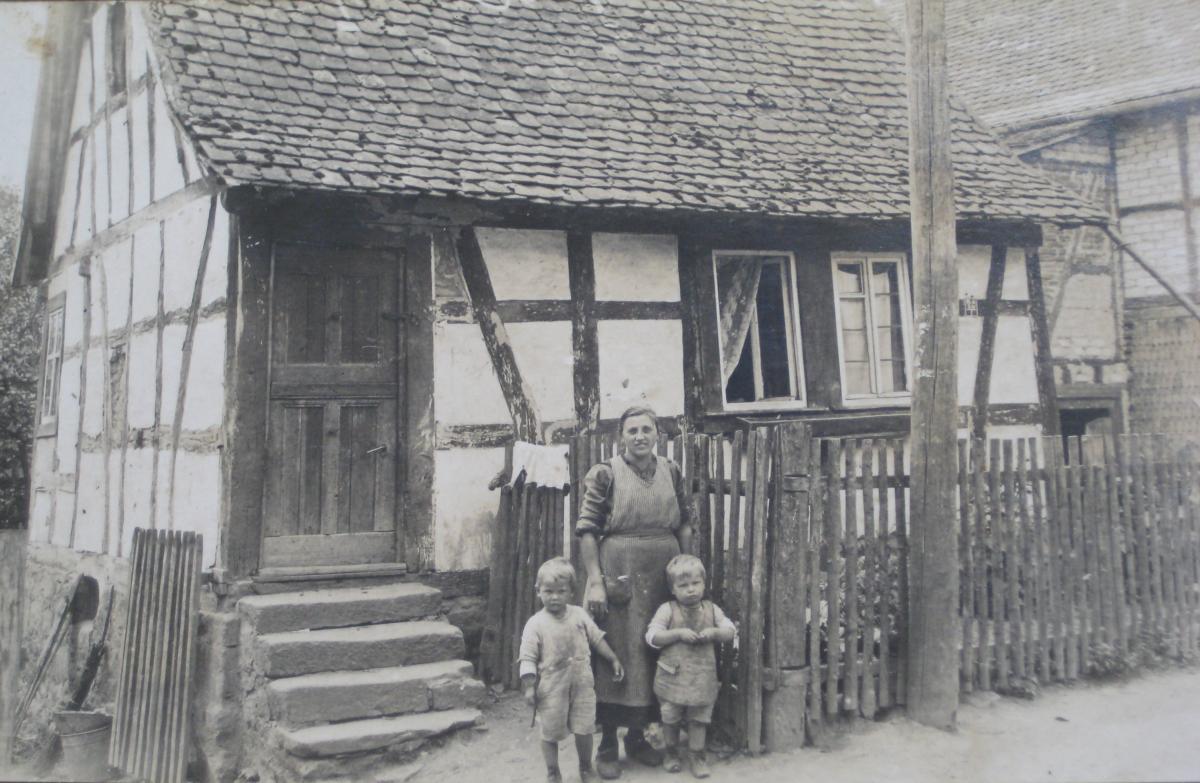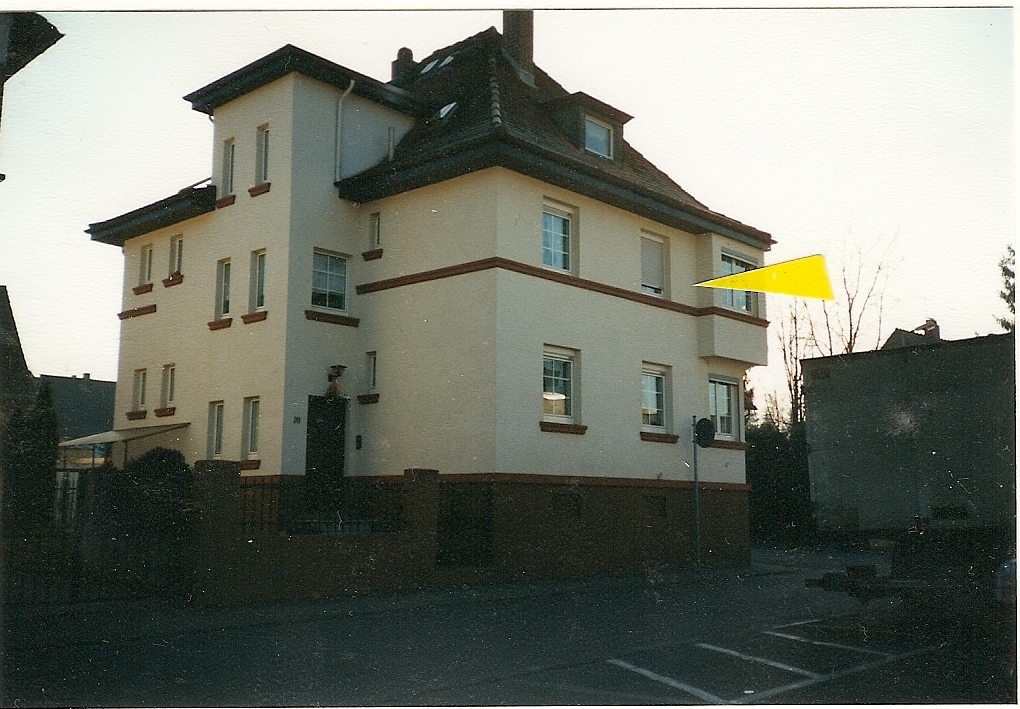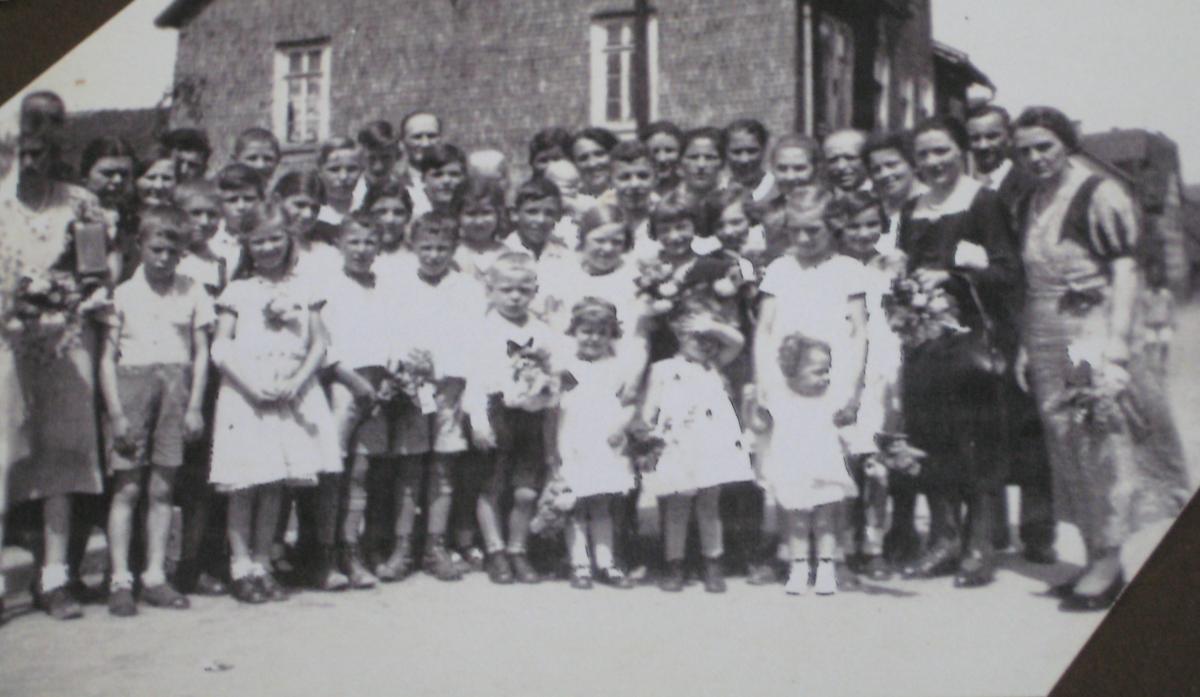Michelstadt Branch
Roger P. Minert, “Michelstadt Branch, Frankfurt District,” in Under the Gun: West German and Austrian Latter-day Saints in World War II (Provo, UT: Religious Studies Center, Brigham Young University; Salt Lake City: Deseret Book, 2011), 114–18.
The charming little city of Michelstadt is located in the Odenwald Forest about thirty-five miles southeast of Frankfurt. Its main attraction is the beautiful city hall that dates to at least 1484, one of the oldest in all of Germany. The Büchler family brought the gospel to this small city just after the turn of the century, but the branch was not officially established there until 1932. [1]
When World War II began, the Latter-day Saints in Michelstadt were holding meetings in a modest building at Horst Wessel Strasse 22. Annaliese Büchler (born 1929) described the meeting place in these words:
There was a large room and one smaller classroom, a cloak room, and a restroom. In the large room . . . there was a large table, and behind that, the branch presidency sat. On the side was a smaller table for the sacrament. We made music with a pump organ. With everybody there, we might have been twenty people in all. The building was right by the street, and there was a sign saying that [the branch] met there. [2]
Surnames represented among the branch leaders in the directory dated June 1939 were Walther, Büchler, Megner, Leopold, and Jakob. [3] Eleven of the thirty-seven registered members at the time held the priesthood.
| Michelstadt Branch [4] | 1939 |
| Elders | 2 |
| Priests | 2 |
| Teachers | 1 |
| Deacons | 6 |
| Other Adult Males | 2 |
| Adult Females | 19 |
| Male Children | 3 |
| Female Children | 2 |
| Total | 37 |
The meeting schedule for the Michelstadt Branch was similar to that of other branches all over Germany: Sunday School began at 10:30 a.m. and was followed by Relief Society. Sacrament meeting was held at 8:00 p.m. Mutual met on Tuesday evenings at 8:00 p.m., and a genealogy class was held on the third Sunday of the month at 8:00 p.m. There was no Primary at the time. When the war began, the branch president was Jakob Walther, and his counselors were Martin Büchler and Heinrich Büchler.
When Germany attacked Poland on September 1, 1939, Annaliese Büchler was a member of the Jungvolk. About here, membership in the Jungvolk, she recalled:
I liked it. For me it was a wonderful time because we learned new things and had fun with all of our friends. Although we had to wear a uniform (a skirt with a white blouse), it was a good time for us. When there was a procession going on, I normally did not attend, but it also did not feel like we had to. Sometimes the leaders complained about us missing the meetings. . . . It even occurred that they slapped me because I missed the last meeting. They even came to our home and picked me up.
For Anna Elise Hosch (born 1924), the war was not a serious concern in the little city of Michelstadt. She belonged to the League of German Girls and enjoyed that, but the war was far away until she began to attend school in Darmstadt. She happened to be home on vacation the night her school was destroyed, as she recalled: “I cried because I could not comprehend how they could destroy the city in which I went to school. I could not go back to school for a while. Later, we could see the fires in Darmstadt from our home [twenty miles distant].” [5]
The year-end report of the Relief Society for December 1940 lends an interesting description to the work done by the sisters in Michelstadt: “Our Relief Society is small but fine. Unfortunately, we have had to restrict our meetings a bit, but otherwise all is in order. We hope that our Heavenly Father will continue to bless, support, and protect our society in the coming year so that we can have a lot of success.” [6]
One year later, the same organization submitted this report: “Our Relief Society is still operating. Due to the war and illnesses, only two reports have been submitted. On November 9, 1941, the Relief Society meeting was merged with the priesthood meeting because only two brethren were in attendance. We hope that our Heavenly Father will bless us in all of our efforts.” [7]
 Fig. 1. The Megner family home in Michelstadt before the war. (O. Megner)
Fig. 1. The Megner family home in Michelstadt before the war. (O. Megner)
The war was difficult for a little girl to understand, according to the recollections of Annaliese Büchler:
As a ten-year-old child, I tried to understand what it meant to be in a war. I knew through the propaganda of Adolf Hitler that he wanted to make Germany a greater country.
Even in school we learned that all the countries that had belonged to Germany before should now come back to [the Reich]. Who did not dream of owning a large property in East Prussia somewhere? This was taught to us over and over again.
According to the branch history written in 2007, the meeting rooms were confiscated by the city for use by refugees, but the branch was assigned some empty storerooms in which they met until 1947. [8] Otto Megner (born 1926) recalled that the new rooms were in the basement of the city hall and that his family had to sneak past Hitler Youth gatherings on Sunday mornings on their way to church. He had to apologize for missing the Sunday meetings, but his leaders were not fanatics who complained about his absence. [9]
 Fig. 2. The building at what was Horst Wessel Strasse 22. The arrow points to the room in which the Saints met in the early years of the war. (M. Esterl 2008)
Fig. 2. The building at what was Horst Wessel Strasse 22. The arrow points to the room in which the Saints met in the early years of the war. (M. Esterl 2008)
While Otto did not have to answer to fanatical Nazis in the Hitler Youth, the same was not true at school. He recalled beginning each day with the singing of the national anthem. “The teacher always came in his SS uniform and often made fun of the members of the Church.” Fortunately, the Megners’ neighbors did not cause them any problems. Otto had other interesting memories of Michelstadt during the war: “In Michelstadt, we did not feel much of the war. The mailman brought the obituary notices for the families whose sons or husbands had died in the war. [The mailman] was an old man who could not hear very well anymore. People would walk out to the street to find out who had died.”
 Fig. 3. A wartime photograph of the members of the Michelstadt Branch. (O. Megner)
Fig. 3. A wartime photograph of the members of the Michelstadt Branch. (O. Megner)
In 1943, seventeen-year-old Otto was called into the Reichsarbeitsdienst and sent to work in the Saarland province bordering occupied France. As he recalled:
I was working in the Reichsarbeitsdienst in the Saarland, and one day I received orders to report to Frankfurt/
Main to be tested to see if I was needed for the air force. I took the train from Saarbrücken to Frankfurt in full uniform. Just as we were entering Frankfurt, the train stopped and could not go on. I had to fight my way [through the aftermath of an air raid] to the army post. The houses next to me on the way were burning. During the examination, I was freezing. There was no heater and I had to stand naked in front of everybody. When that was over, everybody went their way and I had to go back to the train station. I took a train to the [Saarland] again.
In July 1944, Otto Megner was drafted and sent to France for training. In six weeks he was prepared for infantry action and had also learned Morse code. By that time, however, the Allied forces had already landed at Normandy and were making their way eastward through France. Fortunately for Otto and his young comrades (seventeen and eighteen years old), they were not sent to the front but moved slowly in the other direction. Dying for the fatherland had lost much of its appeal by that time. According to Otto, “I would not describe myself as a soldier who really stood behind what the war was about. I did what I was assigned to do without much conviction. Back then, I did not even understand everything that was happening.” The war came to an end for Otto when he was taken prisoner on September 11.
“It seemed like we were far away from the happenings in Darmstadt and Frankfurt/
We knew about the attacks and heard the sirens. Later in the war, we felt the earth quake and saw the fires, although we were 25 miles away. During the day, we could see the planes fly over us and during the night we could hear them. . . . Once an airplane crashed in a nearby forest. We went out to look at it—it was a horrible sight. It was a British plane with Polish soldiers in it. The dead are buried in the Michelstadt cemetery. They could still be identified.
Although the citizens of Michelstadt were quite safe, the same was not true of their relatives elsewhere. Annaliese Büchler’s aunt was killed in an air raid on Frankfurt: “My mother went there with my oldest sister so they could identify her. It was a terrible thing for us to deal with.” She remembered that the Michelstadt Saints sent food and other items to the members of the branches in Darmstadt and Frankfurt and that members of those branches came to Michelstadt after losing their homes in air raids. “We knew each other well, having attended district conferences together.”
Anna Elise Hosch recalled that her family’s home was not destroyed during the war. They were grateful for the Lord’s protection and were willing to share their rooms with some of the many refugees who arrived in Michelstadt from Darmstadt and Frankfurt. Her mother was one of the many devout members who had no trouble introducing the Church to strangers. As Anna Elise recollected, “Whenever my mother talked to someone for more than five minutes, she would find a way to talk about the gospel.”
Life for POW Otto Megner in France was not pleasant, as he recalled:
We were all put into a camp and when we arrived, five hundred to a thousand other prisoners were already there. It was an old post of the Foreign Legion in Langres. When I think back to my time in the POW camp, one word still comes to mind: hunger. I also think about lice, not having enough clothing, and seeing no soap for weeks on end. We also did not have medical services. It was a French camp. They really did not like the Germans at all.
When the American army tanks rolled into Michelstadt on March 29, 1945, they were greeted by a sea of white flags and sheets hanging out of windows. The Hosch family was evicted by American officers but restored to their home after a few days by an American soldier who became their friend and intervened on their behalf.
American soldiers searched the Büchler apartment, as Annaliese recalled: “The soldiers looked through our home to see if we owned weapons or hid soldiers anywhere. I remember how they opened our closets and looked through our things. I was pretty angry at them for doing that! But all in all, they were nice and did not take anything from us. My father even hid his binoculars because he was scared that they would be taken.”
The final branch report for the year 1945 reads: “With the changes in government it was not possible for us to hold regular meetings. Otherwise there is unity in the organization and we are grateful for the blessings of our Heavenly Father. We hope to make improvements next year.” [10] It is interesting to note that whereas the discussion topics in Relief Society meetings at the beginning of the war included “Goethe and the Gospel” and other cultural themes, the topics in the last war year included “Obedience” and “Receiving Blessings from the Lord.” [11]
In 1947, Otto Megner ceased to be a POW and became a guest worker. With no jobs available at home, he chose to stay in France. He prospered there and was able to send valuable items to his mother in Michelstadt. He remained in France until 1952. Looking back on the war, he made the following observation: “The entire time I was [in France], I never met another soldier who was LDS. . . . I also did not have the scriptures with me. I relied on prayer and the Spirit. There were many occasions in which it was obvious that I was guided by the Spirit and even angels in order to make the right decisions. I was always a member of the Church at heart.” Otto’s twin brother and two elder brothers were fortunate to survive their years in the German military and eventually return to Michelstadt.
The city of Michelstadt had 4,093 inhabitants in 1939. Almost all civilians survived World War II unscathed, but 238 men lost their lives in the service of Führer, Volk, and Vaterland. [12] The members of the small but strong branch had fared quite well during the war; none lost their homes and only two (one soldier and one infant) died during those difficult years. The Saints were in a good condition to begin life in a new post-Hitler Germany and looked forward to the day when they would have their own meetinghouse.
In Memoriam
The following members of the Michelstadt Branch did not survive World War II:
Georg Arzt b. Michelstadt, Erbach, Hessen, 7 Jun 1911; son of Peter Arzt and Elisabeth Rausch; bp. 20 Dec 1931; conf. 20 Dec 1931; m. 21 Aug 1940, Anna Grenz; k. in battle 19 April 1945. (CHL microfilm 2458, form 42 FP, ft. 37, 298–99; FHL microfilm 68801, no. 1; IGI; FHL microfilm 68791, no. 384)
Peter Ross b. Gadernheim, Bensheim, Hessen 22 Jul 1941; son of Peter Ross and Eva Marquart; d. intestinal surgery 16 Mar 1942. (FHL microfilm 68791, no. 622; Frankfurt District Book II; IGI)
Notes
[1] Michelstadt Branch, “Seventy-Five-Year Anniversary” (unpublished manuscript, 2007).
[2] Annaliese Büchler Pils, interview by author in German, Darmstadt, Germany, August 19, 2008; unless otherwise noted, summarized in English by Judith Sartowski.
[3] West German Mission branch directory, 1939, CHL 10045 11.
[4] Presiding Bishopric, “Financial, Statistical, and Historical Reports of Wards, Stakes, and Missions, 1884–1955,” 257, CHL CR 4 12.
[5] Anna Elise Hosch Egly, telephone interview with Jennifer Heckmann in German, January 14, 2009.
[6] Michelstadt Branch Relief Society minutes, CHL LR 5518 14.
[7] Ibid.
[8] Michelstadt Branch history.
[9] Otto Megner, interview by Jennifer Heckmann in German, Darmstadt, Germany, August 22, 2007.
[10] Michelstadt Branch Relief Society minutes.
[11] Johann Wolfgang von Goethe was possibly Germany’s greatest writer and philosopher.
[12] Michelstadt city archive.
